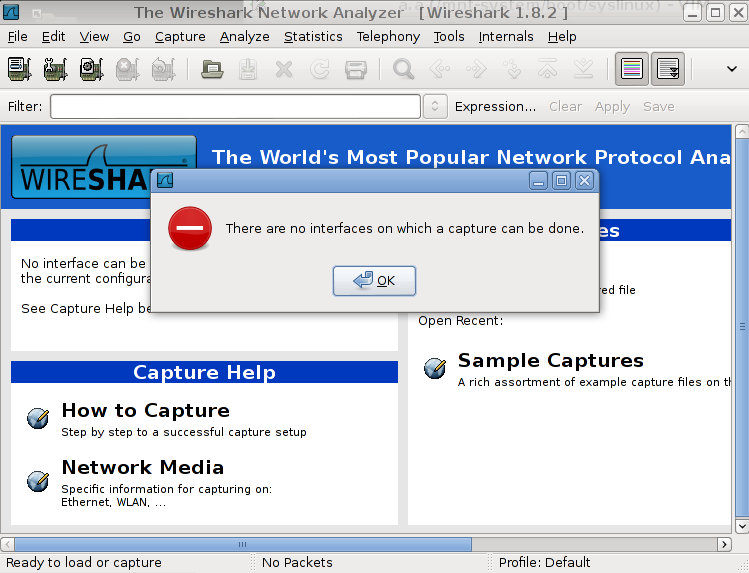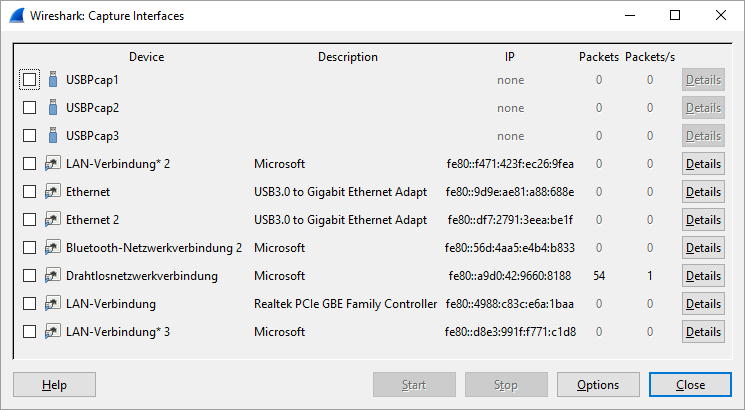
- #Interfaces disappeared in wireshark windows update
- #Interfaces disappeared in wireshark windows windows
Next I disable SecureXL for System A's IP address and start an fw monitor -e. Nothing in the fw ctl zdebug drop output related to the connection at all, so it is not being dropped/blocked by the Check Point code. Transfer of the poison file commences and stalls as expected. So I login to the Check Point firewall and run fw ctl zdebug drop. Matching speed and duplex were verified on all network interfaces and switchports. Customer was only using Firewall and IPSec VPN blades on this particular firewall, so no TP or APCL/URLF.

Sending the poison file between systems located on System A's same VLAN/subnet worked fine, so the finger was being pointed squarely at the firewall. The file would also be blocked if it was sent to a completely different destination "System C" through the firewall. All other files could be transferred just fine between the two systems and there were no performance issues, and by this time the problematic file had been dubbed the "poison file".
#Interfaces disappeared in wireshark windows windows
So when Customer Windows System A would try to transfer a certain file using cleartext FTP through the firewall to Customer Windows System B, the transfer was stalling at about 5MB and never recovering, always in the exact same place in the file. I agreed to take a remote look thinking it would be an easy fix, little did I know that it would stretch into many long days culminating in threats to rip out all Check Point products. Apparently a certain file was being blocked by the firewall with no drop log, and no one could figure out why. I was asked to take a look at a problem for a midsize Check Point customer. Let's see if anyone here can top this story, it was many years ago but just about made me lose my mind. Oh boy, where do I even start with this one. A more complex one would be an application layer issue. The simplest example is that the server is not listening in the requested port. This may be a variant: "it's not my firewall"


Asymmetric routing issues, where the traffic goes through one member and comes back through the other member of the cluster.Related to remote access VPN (this year has been quite active in that matter), some device at the WAN side is blocking the ISAKMP UDP 4500 packets directed to our Gateways, but not the whole UDP 4500.

#Interfaces disappeared in wireshark windows update
(I'll update this list with new suggested issues): To narrow down the circle, I'm specially focusing on networking issues, but every idea is welcomed.ĭo you think it would be useful to elaborate such list? What issues do you usually find? Of course, assuming the firewall side is properly configured (which would be a "firewall issue" but due to a bad configuration). But what I would like to point is not the troubleshooting, but the issues themselves. Probably there are several simple tools that one should use first, like: traffic logs, fw monitor, tcpdump/cppcap, etcetera. It's a quite generic topic, and in terms of troubleshooting it's probably even more generic. I'm looking to build a brief list of typical or somewhat frequent issues we face, where "the firewall" is reported as the root of the issue, but finally it isn't. A security gateway (a "firewall") do a lot of "intelligent stuff" more than just routing traffic (and -in fact- many network devices today do also "a lot of things") so I understand there is a good reason for thinking about the firewall but, at the same time, there is a big number of times where it's not anything related to it, or when it's not directly related. We all know that "the firewall" is one of the first things people blame when there is a traffic issue.


 0 kommentar(er)
0 kommentar(er)
